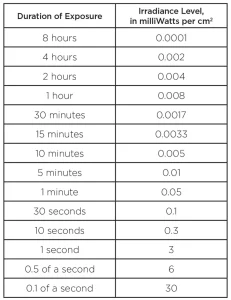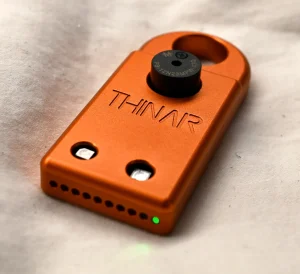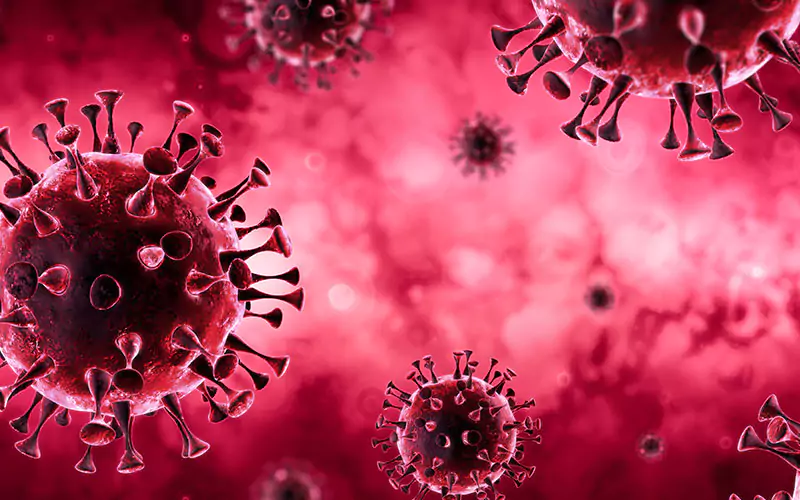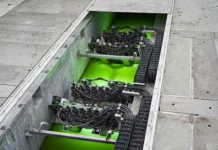James Wiebe, CEO, Thin Air Energy
People want to learn more about ultraviolet light and its beneficial use in controlling COVID-19 and other viruses. To use a worn but accurate cliché: “This is a rapidly evolving area of research.”
Background on UV-C irradiation
Ultraviolet energy in the UV-C band has been shown to be effective against various germs and viruses, with decades of associated scientific study. Recently, the FDA has commented that UV-C radiation may be effective in inactivating the SARS-CoV-2 virus.1 At the start of the pandemic, there was an assumption UV-C would kill the virus. That assumption has turned into a near certainty.
Efficacy, which means the ability of UV-C to be effective in killing viruses,2 has been repeatedly demonstrated in published research.3 The research shows various germs and viruses along with corresponding fatal doses of UV-C irradiation, along with surface types and many caveats.
The research of UV-C spans decades; it substantially precedes the recent novel coronavirus. But efficacy in killing pathogens on surfaces and in the air may not be related to the overall control of the virus.4 What this suggests is that surface and air UV-C irradiation must be considered a component that may be improved and better understood over time.
UV-C radiation covers the wavelengths from 100 to 280 nanometers. UV-C radiation is generated by the sun but is not received at the surface of the earth, because of the filtering capability of the atmosphere. UV-A and UV-B, which are lower in frequency, pass through the atmosphere in varying degrees but do not show the same ability to immobilize pathogens.
Manmade UV-C was originally produced utilizing tubed lamp emitters. While these tube UV-C products are popular, more recently, solid state LED-based UV-C solutions have been commercialized.5
A benefit of LEDs is long life, with resulting lower cost of operation over time. LEDs do not operate in the exact same frequency as tube products. Also, tube products may be subject to legislation because of the harmful effects of their gases when they break or are removed from service.6
Furthermore, some UV-C tubes operate at frequencies that may cause ozone to be created. This adds additional questions to the discussion of effectiveness and safety.
Across the 100 to 280 nanometer spectrum, points of commercial interest have occurred because of potential efficacy, safety and producibility. Wavelengths in the 207 to 222 nm range are called far-UV-C and are in the process of being commercialized. Benefits include strong antiviral characteristics without being as harmful to humans, but this research is ongoing.
Radiation at 254 nm is produced by the tube emitters and also produces ozone (222 nm radiation also may cause the formation of ozone). Wavelengths in the 255 to 280 nm range are usually produced by LED emitters, with cost saving and longer life capabilities. Conversely, these LED emitters have not been very power efficient and are overshadowed by tube emitters where UV-C power output efficiency is a consideration. Even so, designers are showing that LED emitters continue to increase in strength and consequent efficacy and relevance.
Can UV-C radiation be used safely?
The safety of UV-C is determined by dosing, which can be a difficult concept to understand. It is directly analogous to an old-fashioned radiation measurement badge (dosimeter), which gives the wearer the ability to determine how much radiation they have received, and that is a function of the radiation strength over time.
A small dose of UV-C, continuously received over a period of hours, is equivalent to a large dose continuously received over a period of minutes. They both have equivalent abilities to cause medical issues or to kill germs and viral particles.
Most UV-C sources are dangerous when a small amount is received over a long period of time, or when a large amount is received over a short period of time. Far-UV-C looks to buck this trend by providing kill power and safety simultaneously.
There is little media coverage that has provided good answers on government standards for safe UV-C dosing. This is surprising given the benefits vs. risks. As it turns out, there is a solid source of information for UV-C dosing recommendations: The American Conference of Governmental Industrial Hygienists provides a table of safe UV-C radiation levels.7 The referenced table is published as part of an ACGIH® Threshold Limit Values (TLVs®) and Biological Exposure Indices (BEIs®).
The document uses a strange word, “actinic,” which begs for a definition. Here are two definitions:
- Referring to the ultraviolet (UV) rays from sunlight and UV lamps. Sunburn is an actinic burn. An actinic keratosis is a skin lesion that is the consequence of chronic sun exposure.8
- Relating to or denoting light able to cause photochemical reactions, as in photography, through having a significant short wavelength or ultraviolet component.9
Actinic radiation causes photochemical reactions (in cells and viruses, for instance) and can cause burns, lesions and cancer. Actinic UV-C radiation is radiation that occurs within the wavelength of 100 to 280 nanometers. As a comparison to visible light, this is a shorter wavelength and is not visible. It does not reach human retinas. It has the unique ability to cause a reaction in living things, causing cellular mutation and death.10
The European authority has substantially different research,11 which apparently contradicts US information and suggests the detrimental effects for UV-C radiation are not there. The differences between ACGIH and the Europa.eu/health source suggests that additional research is needed.
Consequentially, measuring the level of UV-C radiation is important. It establishes both safety and effectiveness.
Does UV-C radiation kill pathogens?
Yes, it does.
As explained previously, the effectiveness of UV-C is determined by dosing level. Recent media has questioned this severely and for good reason. A lot of consumer products are simply not effective. Fake products add to the pot of confusion.13
The desire for UV-C irradiation is to kill things in various places, including: in the air;14 on surfaces;15 on objects, such as a piano;16 on computer keyboards and mice;17 in portable applications, such as in a car;18 in airplanes;19 and on reusable devices, such as N95 masks.20 According to The National Academies of Science:21
Claim: UV light destroys the novel coronavirus that causes COVID-19.
Finding: TRUE. Specifically, UV-C light has been shown to quickly inactivate the novel coronavirus SARS-CoV-2. It can be an effective disinfectant but needs to be used correctly to avoid skin and eye damage.
So, how? The answer is UV-C radiation penetrates the pathogen and disrupts the DNA or RNA of that pathogen.22 It also disintegrates the surface membrane.
What are safe UV-C dosing levels?

Table 1 shows a snippet of the UV actinic dosing table23 showing published safety standards.
After multiplying the duration of each line (in seconds) times the level (in milliWatts), the result is milliJoules (mJ). And for each line, the calculation produces a value of 3 mJ.
To emphasize, it is the same resulting dose value for every line. They are all the same dose. Per ACGIH, this is a daily limit exposure of UV-C: 3 milliJoules.
How might UV-C strength and dose be measured?
GEIGER UVc™ is an example of a product that is designed to show field strength and dose of UV-C radiation.24 It has an LED display that shows instantaneous UV-C field strength (covering 220 nm to 280 nm bandwidth), while ignoring visible light and, most of all, UV-A and UV-B radiation.
In addition to field strength, it also shows dosing levels over time. It is designed to ignore interference from close band radiation; e.g., UV-A and UV-B.
GEIGER UVc shows increasing field strength covering a range of 3 Log.25
An example of UV-C effectiveness vs. safety

GEIGER UVcTM immediately shows field strength and then shows dose level over time. These values are critical to understanding whether a UV-C emitter will have germicidal and antiviral qualities.
The National Institutes of Health (NIH) published a paper on killing influenza virus in an aerosol form with a reduction in viral loads to around 98%. This was achieved by a field strength of 15 Joules per square meter, and that is equivalent to an exposure of 1.5 millijoules per square centimeter.
If GEIGER UVc™ shows a dose of 3 millijoules, then the kill strength of the underlying product being tested was higher than the UV-C source in the study NIH study. In other words, 3 milliJoules > 1.5 milliJoules, and 1.5 milliJoules was shown to produce influenza reduction levels as high as 98.2%.
This also suggests there is a correlation between the safe use of UV-C and the effective use of UV-C. It is possible to kill viral loads at the 98% level with a dose that is below 3 mJ.
The NIH report showed efficacy up to 98.2%, but that is not necessarily the overall efficacy of a true user experience. Here are some variables:
- The report had a controlled laboratory set-up that no home or office can match. Results were measured with humidity and temperature-controlled, and no home or office is controlled in the same way.
- A particular frequency of UV-C was used, and many products use a different UV-C frequency, which may not be as effective (or may be more effective).
- The air in the study was static, not moving through the radiation field.
- Efficacy against different types of organisms was measured but with inadequate breadth of organisms.
- Is 98.2% particularly meaningful?
As the pandemic has progressed, is UV-C irradiation of increasing value?
Yes. The following shows the case for UV-C is strong:
- Decades of research have shown the proven viral efficacy of UV-C.
- Methods of usage have been developed for safety. These developments include ongoing research in far-UV-C. Robots may now apply irradiation, for example, in hospital rooms when humans are not present. Embedded UV-C in ducting provides complete safety for homes and businesses.
- Devices that easily measure strength and alarm on dosage are now available.
- In addition to viral efficacy, UV-C demonstrates great results with germs as well.
- The most recent research is providing certainty that UV-C inactivates the novel coronavirus.
- While speculative, there is a likelihood that mutant pathogens also will be inactivated by UV-C. “UV-C LED, … can effectively inactivate microorganisms regardless of taxonomic classification.”
- Recent power increases and cost reductions in UV-C LED products provide a vector to more effective products and solutions.
Conclusion
UV-C irradiation products can be designed and used in a safe manner. Demonstrable efficacy in immobilizing the novel coronavirus has been achieved. Published safety guidelines are available, albeit with some disagreement.
The ability to test strength and density of UV-C is easily available. Far-UV-C provides promise for safety and efficacy as well. UV-C LED devices with lower cost and more power provide a vector for better products and systems for immobilizing virus and other pathogens.
Contact: James Wiebe, [email protected]
References
- UV Lights and Lamps: Ultraviolet-C Radiation, Disinfection, and Coronavirus | FDA
- Author’s note: Efficacy is not quite the same as effectiveness, but I will use those words somewhat interchangeably in this paper.
- https://www.ajicjournal.org/article/S0196-6553(15)00303-X/pdf
- What You Need to Know Regarding Products Making Claims to Kill the Coronavirus Causing COVID-19 (epa.gov)
- https://en.wikipedia.org/wiki/Germicidal_lamp
- https://www.lightingeurope.org/images/publications/general/LE_-_FAQ_-_UN_Minamata_and_EU_Mercury_regulation_-_20200124.pdf
- https://www.nsc.org/Portals/0/Documents/facultyportal/Documents/fih-6e-appendix-b.pdf (page 1042)
- https://www.medicinenet.com/script/main/art.asp?articlekey=19890
- https://www.lexico.com/en/definition/actinic
- https://www.insider.com/does-uv-light-kill-germs
- https://ec.europa.eu/health/ph_risk/committees/04_sccp/docs/sccp_o_031b.pdf
- https://www.ctvnews.ca/health/coronavirus/can-uv-light-kill-the-coronavirus-experts-break-down-online-claims-1.4885104
- https://hackaday.com/2020/04/15/buyer-beware-this-led-bulb-sold-as-germicidal-doesnt-emit-uv-c/
- https://www.blueair.com/us/blueair-life/air-purifiers-allergies/colds-viruses.html
- https://www.tandfonline.com/doi/full/10.1080/15459620701329012?scroll=top&needAccess=true&
- https://www.hollywoodpiano.com/coronavirus-protection-procedure-for-piano-keys/
- https://infectioncontrol.tips/2019/06/26/evaluating-a-no-touch-UV-C/
- https://www.forbes.com/sites/marshallshepherd/2020/05/16/could-sunlight-and-heat-in-your-car-be-a-weapon-against-coronavirus-on-packages-and-masks/#281e94e823d7
- https://www.flightglobal.com/business-aviation/maker-of-virus-killing-cabin-air-purifier-ramping-up-production/138216.article
- https://www.ncbi.nlm.nih.gov/pmc/articles/PMC4699414/pdf/UOEH_12_1018518.pdf This particular topic deserves a separate paper.
- Does ultraviolet light kill the coronavirus? | National Academies
- Does UV Light Actually Disinfect and Kill Viruses? – Beckman Laser Institute (uci.edu)
- https://www.nsc.org/Portals/0/Documents/facultyportal/Documents/fih-6e-appendix-b.pdf (page 1042)
- https://www.thinairenergy.com/geiger-uvc
- 3 Log means that 0.0004 x 1000 = 0.4. x 1000 means ‘3 Log’ multiplier, or 3 orders of magnitude strength value.
- https://www.ncbi.nlm.nih.gov/pmc/articles/PMC3298127/
- UVC LED Irradiation Effectively Inactivates Aerosolized Viruses, Bacteria, and Fungi in a Chamber-Type Air Disinfection System – PubMed (nih.gov)





